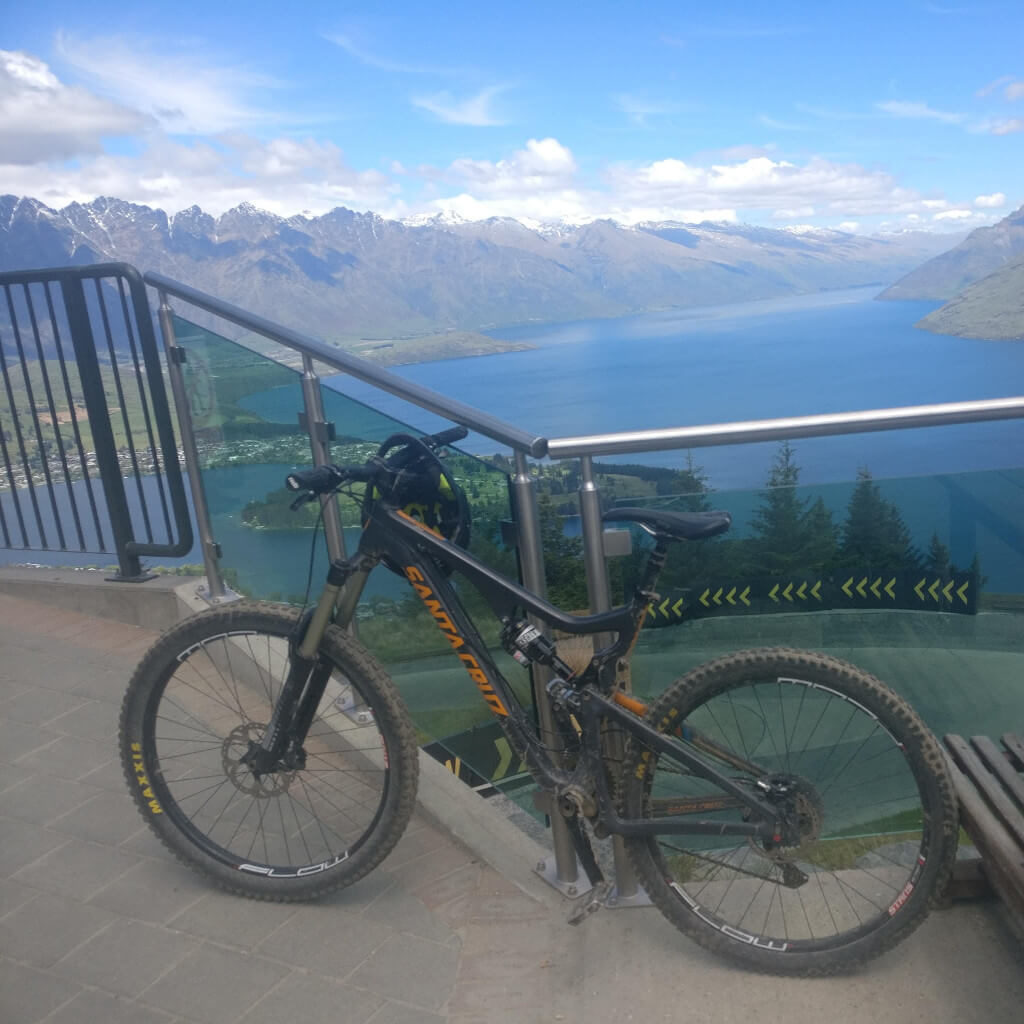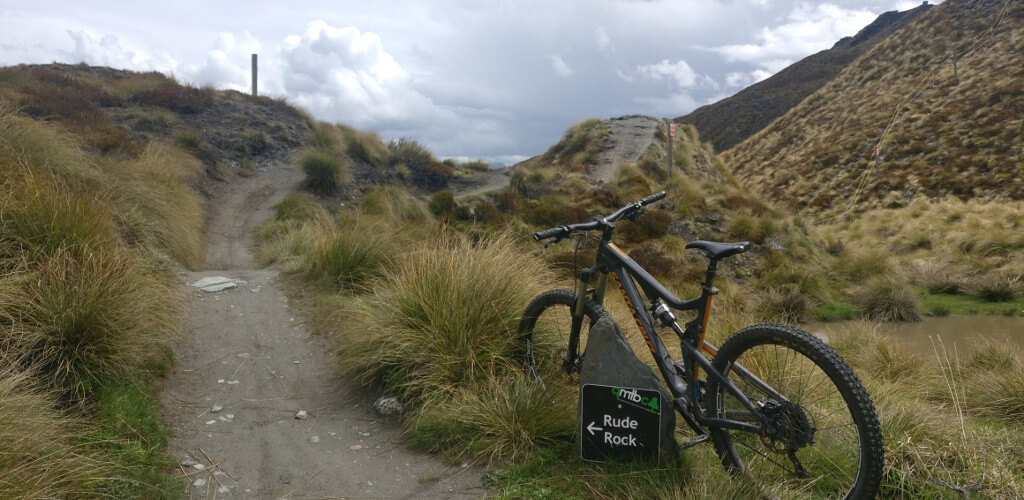Your saddle should ideally be as low as possible, so that it never obstructs you from moving your body position around the bike during descending or other technical riding. You should be able to easily get your body over the back wheel, and back again, if you need to.
Today we are looking at something which while familiar to most experienced mountain bikers, many riders getting into the sport might not be sure about.
As with most bicycle types, mountain bikes usually allow the seat post to be raised and lowered a significant amount, either via a remote dropper switch, or manually adjusting via a seat tube clamp adjustment.
This will dramatically change how well suited your mountain bike is to climbing uphill, descending steep trails, jumping, and most other things you can do on two wheels!

So what are the benefits of having your seat low?
Body position when out riding is super important, and having a lower saddle position allows you to more freely move your body position in every direction – back and forth on the bike, but equally side to side and every which way.
This means that you can more easily and confidently hit steep descents and most other types of technical terrain when stood up out of the saddle on your pedals.
The same applies to jumping.
You might have seen World Cup level cross country (XC) riders managing to tackle both large jumps and steep descents on their super light XC bikes, despite having very high saddles (best suited for maximizing seated climbing power) – but these are exceptions to the rule.
The vast majority of us are nowhere near as skilled on a bike as those riders, and getting bucked forward by incorrect body position and a high saddle, or just getting caught up trying to move our body around on the bike, can often lead to unnecessary crashes.
There is a reason that all dedicated downhill bikes have an extremely low saddle position (and no dropper post to allow it to be moved up and down).
Downhill riders just need the saddle low and out of the way.
Other mountain bikers riding dirt jumps or urban street tricks have the same setup – they need to be free to move around on the bike in the air or when riding whatever technical challenge.
This is also one less thing to worry about getting caught up on when bailing off the bike mid-crash. It’s vital to try and get away from the bike during many of these crashes, so the last thing you’d need would be a high seat getting you tangled up in your legs as you try and eject yourself off the bike mid jump for instance.
But at the end of the day, for most mountain bikers on a modern trail/enduro bike, you’ll (hopefully) have a dropper post, which gives you the best of both worlds at the flick of a lever on your bars.
High position for seated climbing power – low position for more capability and confidence on descending technical terrain or hitting jumps.
Why is body position so important?
This is one of those things that once you’ve been riding for long enough is easy to completely take for granted.
We naturally become accustomed over time as to how to move more fluidly around the bike as we take on more challenging trails and features – and yet learning about this early on in your mountain biking journey is super helpful.
Often riders starting out will very much be passengers on the bike.
What I mean by this is that they’re basically going where the bike takes them, either on the terrain or in the air – rather than positioning their body and limbs and directing the bike precisely where it needs to be.
It’s one of the reasons that learning to mountain bike has quite a steep learning curve in my opinion.
Those scary moments early on, where you’re bucked forward on a jump, or go sailing over the bars due to completely wrong body position – they can be painful (and usually are), but are often going to be something you are determined not to let happen again.
It becomes such a powerful component in your skills on the bike though as you learn, and being able to manipulate the bike around on the trail, or in the air, by using simple shifts in body weighting and position are a game changer.
A great example of this is learning that dropping your heels and getting your weight back further on the bike when you’re descending very steep trail can help keep your weight centred on the bike, and give you great footing/braking confidence as you take on a challenging descent.
What sorts of features benefit from low seat position?
We’ve already covered a range of them, and really it covers a wide range of the various types of mountain biking, and features within them:
- Drops
- Jumps
- Steep downhill trails
- Street / skatepark riding
- Technical trails
- Rockgardens
- Skinnies
For virtually all of these, it’s primarily the ability to easily shift body position around the bike that plays the biggest part.
Increasing your ability to bail off the bike during (or before) a crash without getting as easily tangled up with it and going down in a flailing ball of arms, legs, and bike is a major benefit too.

Downhill vs Enduro
The lines have become increasingly blurred over the last few years, as modern trail bikes (and their slightly beefier cousins, Enduro mountain bikes) have become more and more capable on the rough stuff.
In the past there was a much bigger divide between what “downhillers” and “XC riders” attempted on their bikes.
Downhill riders would hit massive jumps and drops, and ride steep gnarly descents, fast.
XC riders would be the fitter riders – climbing big hills, but only cautiously descending – and primarily riding long distances on relatively low consequence trails.
But now it is super common for large numbers of enthusiastic mountain bikers in most countries to take on gnarly downhill trails filled with chunky rockgardens, gap jumps, wallrides, large drops and steep chutes on little more than a modern trail bike, often with only a half shell trail riding helmet and some light knee pads.
Thankfully most trail/enduro bikes now come equipped with a dropper post, to allow riders to seamlessly switch their saddle height to suit the climb or descent, without stopping to adjust.
Dropper post vs no dropper
Downhill bikes you’ll see sold as standard without droppers on them (as they are solely used for descending, and have no need for a climbing position).
Likewise XC bikes, but for very different reasons – that is, to keep them as low weight as possible, and primarily cater for power climbing uphill and long distances of undulating trail under pedal power.
You’ll still find mostly entry level trail bikes and many hardtails being sold without a dropper post – but once you get around the couple thousand price point you’ll find all trail/enduro bikes have a long dropper post as standard.
This will give you usually at least 150mm – and up to 210mm in some cases – of height adjustment, allowing even the lankiest of riders to have both an awesome descending seat position and powerful climbing position.
Different saddle profiles
It is important to note when discussing seat height, that the saddle design (and unfortunately cost) can also play a big part in how effectively the rider is able to move around on the bike when standing on the pedals.
This is because the cheaper, more casual/comfort saddles are usually much bulkier in size and design – which can make it noticeably more different to move side to side or back and forth over the back of the bike.
XC racing saddles for instance will always be very slim sleek design, with minimal weight or bulk to them – which does allow for more easily adjusting body position.
Trail/enduro saddles that are more expensive upgrades to the casual/comfort types while often stronger/heavier than their XC counterparts, will usually still have elements of that thinner/sleeker design – often with angle corners at the back to allow for ease of forward and backwards body repositioning.
My take on the topic, as an experienced mountain biker
Saddle height is really important when out on the trail – and can drastically change the capability of the rider and enjoyment of the ride.
I *still* have my original Rockshox Reverb 125mm dropper post on my Bronson, which I’ve had for around 7 years at this point.
It neither works smoothly or has enough drop for my liking. Due to my 6’1 height I have to run quite a bit of the post sticking out of the frame to reach a reasonable seated pedaling height, so even when I fully slam the post back down it still sits reasonably high.
But it will do until I upgrade to a OneUp 210mm post. And that will be an awesome day, as the saddle will sit much lower and out of the way.
Moral of the story – get a dropper post if you don’t have one, it will change your experience of mountain biking forever.
Trust me on this.
But either way, get out and enjoy riding your bike.
That’ll what it’s all about.

